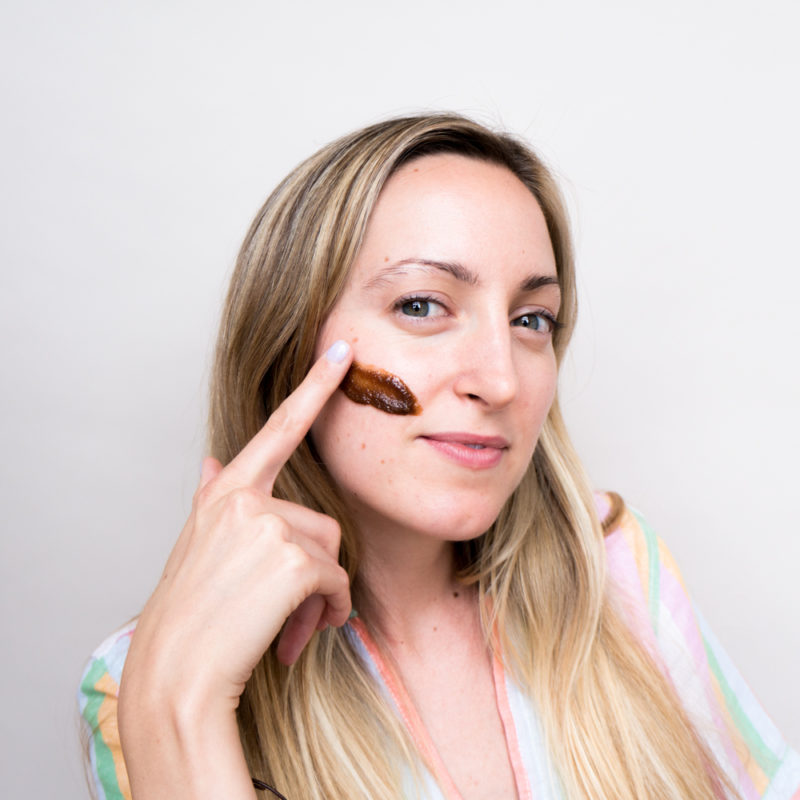Over-exfoliating is easy to do- good thing there are tell tale signs of over exfoliation that we can act on. Repairing your skin after the fact? That can be tricky. Learn what warning signs to look for and how to effectively do damage control below.
There are few things in skin care that are more satisfying than exfoliating your skin. There’s a special joy with waking up with glowier skin the morning after applying an AHA, and the baby-soft skin that’s left the moment you rinse off a face scrub is heavenly.
RELATED: The Right Way to Incorporate Acids Into Your Routine
Exfoliation is a super important part of the skin care regimen, essential to keeping your pores clear of dead skin cells and helping your skin healthily and fully completing its turnover cycle.
However, there can be too much of a good thing, and it’s not hard to over-exfoliate your skin. Whether you prefer to apply an exfoliating acid or scrub away your skin with a physical formula, it is possible to do too much.
There are several ways that your skin shows signs of over-exfoliation. Read on to discover five common ones.
Redness and Irritation
This one may seem obvious, but that’s why it’s number one—it is most likely to be your first sign of over-exfoliation. It’s not unusual for the skin to be slightly red immediately following exfoliation, but if it remains red hours after or the next day, that means you need to tone it back a bit.
Sometimes the skin can get itchy or you may experience a slight burning sensation when applying a chemical exfoliant, signaling that your skin’s barrier has been broken down by your exfoliation. If you feel tingling or burning sensations with your other skin care products, you’ll want to reassess your exfoliating product or frequency.
Increased Dryness and Flakiness
Over-exfoliation can cause your skin to become dehydrated and dry. If you notice that you are developing dry patches or flakes, you may be over-doing it. This is why it’s also important always follow exfoliation with hydrating and moisturizing products.
Increased Oil Production
For oily, combination, and some normal skin types, the dehydration may manifest itself in the form of the overproduction of oil. This is because your skin over-compensates by producing excess oil to protect itself and try to re-hydrate. This is why even oily skin types need to moisturize.
Acne
Believe it or not, over-exfoliation is actually a major reason people develop acne, or why their acne won’t go away. Although a moderate amount of exfoliation is a great way to prevent pimples by keeping the pores clear of debris, going overboard can actually weaken the skin to a point where it cannot defend itself as well against bacteria and infections. This means its front line of defense is broken down, and it is much easier for pimples to form.
Further, physically exfoliating over active acne can actually spread the infection to other parts of the face, so it is extremely important to note if you see breakouts developing or lasting longer than usual, and adjust your exfoliation accordingly.
Shininess
Shininess is the final warning sign that’s often misinterpreted as a positive outcome. We all want dewy, shiny skin that has a natural highlight and glow. However, if your skin starts to become shiny and translucent looking after you exfoliate, this actually isn’t a good sign.
This shininess is actually the result of your skin being stripped of its natural texture, and is an indicator of a weakened skin barrier. Your dewiness should come from essences, moisturizers, and other sources of hydration – not your stripping exfoliators. So, if you start to see a translucent shine appear on your skin after you exfoliate, it may be time to pedal it back.
How to Treat Over-Exfoliation
If you start to notice any of the above indicators, stop exfoliating for a week or so to let your skin recover, and then ease back into it. Going forward, we recommend exfoliating just 2-3 times per week. If you prefer chemical exfoliation, you may also want to look for products with a lower percentage of acids.
In the meantime, there are some repairing products you can use to help your skin recover.
Look for products that are specifically targeted at re-building that barrier, and protecting and hydrating your skin. The SkinRX Lab Madecera Cream does this with ingredients like ceramides. Then madecassoside offers supreme soothing powers. The cream is also packed with powerhouse ingredients niacinamide and adenosine that work to give your skin that desired “glow up” and reduce the appearance of fine lines.
A few days a week, swap out the moisturizer with hydrating treatment like the Thank You Farmer’s Back to Relax Soothing Gel Mask. Formulated with pomegranate, fig, and aloe vera juice, it helps expedite the healing process and calm the skin’s surface, while delivering a powerful dose of hydration and moisture.
Both of the products above can be found in the Dynamic Duo: Skin Soothers exclusive to Soko Glam ($55 for a $74 value).
Another option is the Plant Base Waterfall Moist Balanced Hyaluronic Acid ampoule. Rich in 100% pure sodium hyaluronate, or hyaluronic acid, that helps replenish moisture levels. Apply a few drops of this ampoule onto your skin every day, and, soon enough, your skin will look more plump and healthy.
If you feel that you’ve over-exfoliated, it’s even more important than usual to apply sunscreen religiously. When your skin’s barrier is depleted, it’s become more sensitive to sun damage which can cause further irritation. Suntique’s I’m Safe for Sensitive Skin uses physical blocker titanium dioxide (which has less potential for irritation than chemical formulas). With soothing ingredients like centella asiatica and aloe leaf extracts, it calms damaged skin and protects skin from environmental stressors while it recovers.
